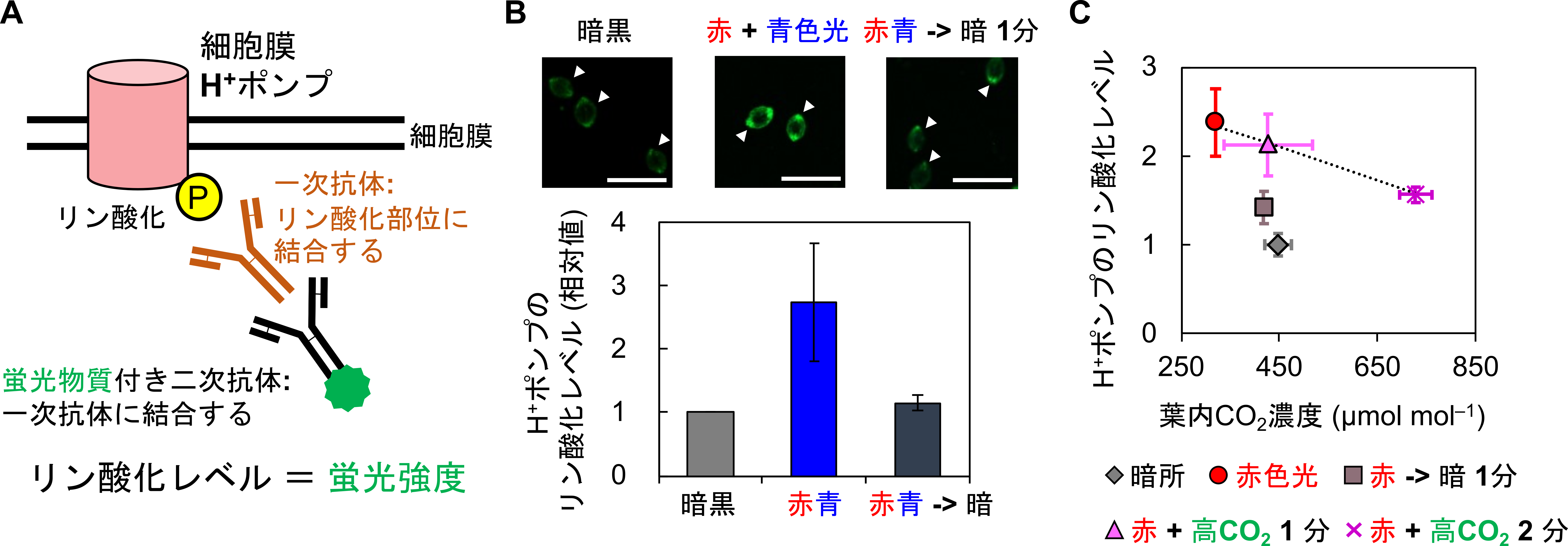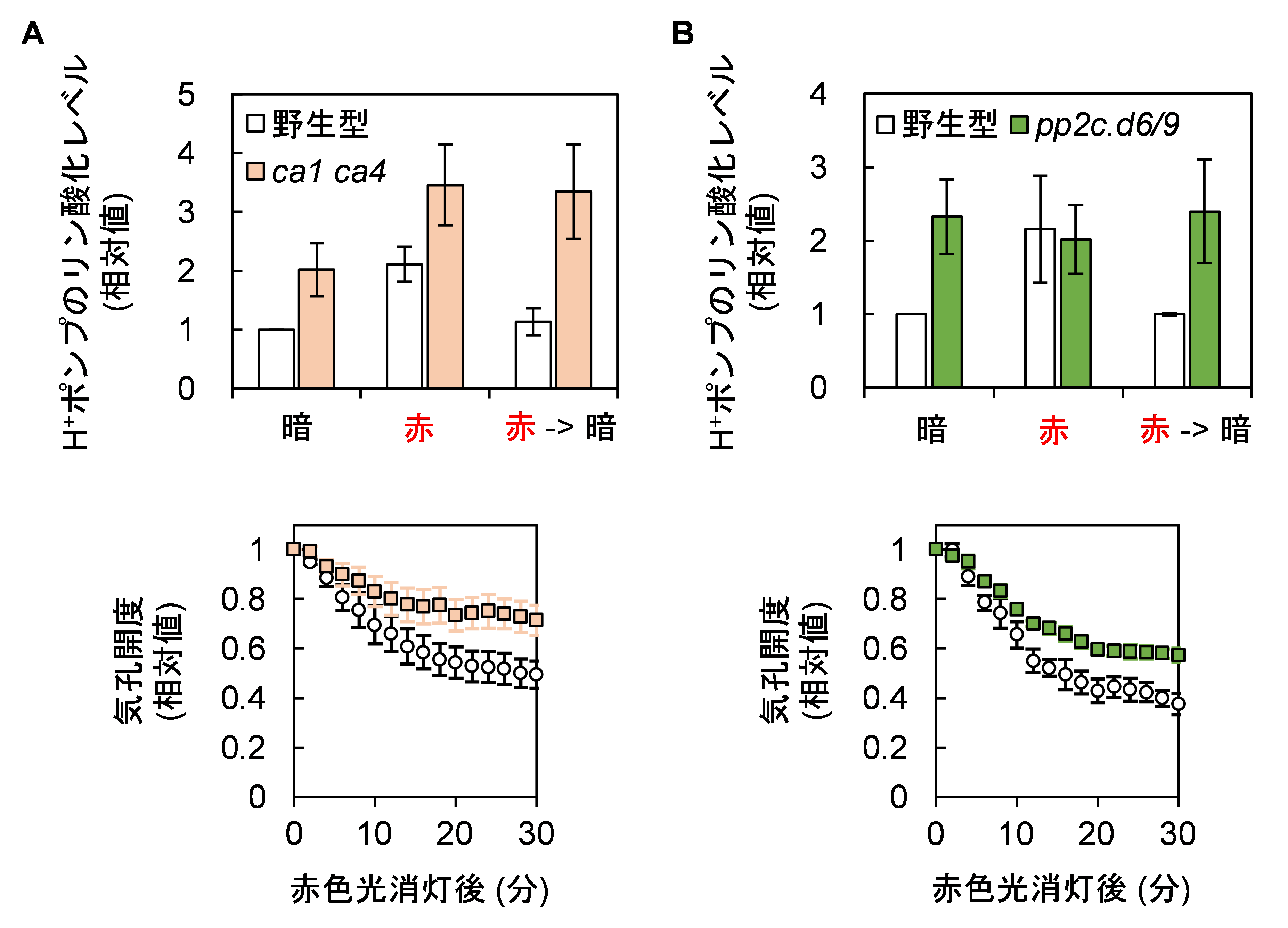DATE2022.10.02 #Press Releases
New Mechanism Discovered for Plant Stomatal Closure in Response to CO2
Disclaimer: machine translated by DeepL which may contain errors.
- Toward more efficient CO2 absorption by crops
Eigo ANDO (JSPS Research Fellow, Academic Support Staff)
Toshinori Kinoshita (Professor, Institute for Transformative Biomolecular Research, Nagoya University)
Ichiro Terashima, Professor, Department of Biological Sciences
Key Points of the Presentation
- We have revealed a mechanism by which stomatal closure is promoted by the dephosphorylation of plasma membrane H+ pumps in plant stomatal pore margin cells in response to increasing carbon dioxide ( CO2 ) concentration.
- We proposed a new mechanism in which stomatal pores, which are the intake of CO2 used for photosynthesis, are regulated by CO2 itself.
- It is expected to lead to the elucidation of the mechanism of stomatal opening and closing in the field, where photosynthetic activity fluctuates, and to the development of technology to improve the efficiency of CO2 absorption by crops to reduce atmospheric CO2 concentrations.
Summary of the presentation
Since the surface of plants has many pores called stomata, which function as a passageway for CO2 necessary for photosynthesis and water related to transpiration (Note 1), it is believed that the control of stomatal opening and closing plays an important role in plant growth and survival. When plants are exposed to light, a protein called plasma membrane H+ pump(Note 2) in pore-forming stomatal cells is activated by phosphorylation (Note 3) to drive stomatal opening. On the other hand, the stomatal pores close in the dark, but the mechanism of this closure has not been clarified.
In this study, a group led by Eigo Ando, JSPS Research Support Staff (affiliated with the Department of Internal Medicine, Graduate School of Science, the University of Tokyo), Professor Toshinori Kinoshita of the Institute for Transformative Biomolecular Science, Nagoya University, and Professor Ichiro Terashima of the Graduate School of Science, The University of Tokyo, and their colleagues have demonstrated that the photosynthetic arrest under dark conditions is accompanied by an increase in leaf CO2 concentration increases in parallel with the cessation of photosynthesis in the dark, they discovered a phenomenon in which the H+ pump is rapidly dephosphorylated. The research group found that the dephosphorylation of the H+ pump can be triggered even under light irradiation by artificially increasing the intra-leaf CO2 concentration. Furthermore, through genetic verification, they identified a gene whose deletion impairs dephosphorylation of the H+ pump and delays stomatal closure.
This finding proposes a new mechanism by which CO2 itself regulates the stomatal uptake of CO2 used for photosynthesis. In the future, this finding is expected to be applied to elucidating the mechanism of stomatal opening and closing in the field, where photosynthetic activity fluctuates, and to technologies for improving the efficiency of CO2 absorption by crops to reduce atmospheric CO2 concentrations.
Announcements
Plants open their stomata in response to light and absorb water and nutrients from their roots through CO2 uptake and transpiration, which are necessary for photosynthesis. Therefore, stomatal opening and closing has been widely studied as important for plant growth and survival, as well as for the carbon and water cycles in the ecosystem. Blue light in sunlight is received by pore cells and activates them through phosphorylation of plasma membrane H+ pumps, and stomatal opening is driven by the action of the activated H+ pumps. More recently, it was discovered that photosynthesis also contributes to the phosphorylation of the H+ pump (Figure 1). On the other hand, stomatal closure occurs in the dark, but the initial process of stomatal closure has not been clarified.

Figure 1: Stomatal function and light-induced stomatal opening.
Plants open their stomata in response to light to facilitate the uptake of CO2 for photosynthesis and the absorption of water ( H2O) and nutrients from the roots through transpiration and Phosphorylation, which is important for the activation of the plasma membrane H+ pump in pore cells, is triggered via blue light in sunlight and photosynthesis. The activated H+ pump drives the accumulation of potassium ions ( K+) and other ions in the cell that are necessary for stomatal opening.
In this study, the research group used the model plant Arabidopsis thaliana to visualize and analyze the phosphorylation state of the H+ pump in the stomatal cells by fluorescence when the leaves are moved from light to dark, i.e., when photosynthesis ceases (Figure 2A). To our surprise, we found that the H+ pump was dephosphorylated in only one minute after the cells were transferred to the dark (Fig. 2B). Since this phenomenon correlated with the increase in CO2 concentration in the leaves due to the cessation of photosynthesis, the research group tested the hypothesis that artificially increasing CO2 concentration in the leaves could induce dephosphorylation of the H+ pump. As a result, it became clear that even under light irradiation, dephosphorylation occurs when the CO2 concentration in the leaf is increased by a factor of 2 (Fig. 2C). This indicates that CO2 induces dephosphorylation of the H+ pump.

Figure 2: Discovery of rapid dephosphorylation of the H+ pump in response to darkness and CO2.
(A) Phosphorylation of the H+ pump in pore-side cells was visualized by fluorescence using an antibody.
(B) Phosphorylation level was shown to decrease (dephosphorylation) at 1 min after the transition from light to dark. (Top) Fluorescence microscopy image of pore-side cells (arrowheads) Scale bar: 50 μm (Bottom) Quantification of fluorescence intensity (phosphorylation level) in pore-side cells.
Next, the research group worked to elucidate the mechanism by which the H+ pump is dephosphorylated by CO2. It is thought that CO2 entering the cell is converted to HCO3- by the action of an enzyme called carbonic anhydrase (carbonic anhydrase; CA) (Note 4), which acts as a signal within the cell. Therefore, we examined mutant (Note 5) plants lacking the genes encoding carbonic anhydrase, CA1 and CA4, and found that the rapid dephosphorylation of the H+ pump was impaired, resulting in slower stomatal closure (Figure 3A). This indicates that intracellular signaling (Note 6) via carbonic anhydrase regulates H+ pump dephosphorylation and subsequent stomatal closure. Furthermore, because H+ pump dephosphorylation was impaired and stomatal closure was delayed in plants lacking PP2C.D6 andPP2C.D9, genes encoding Group D type 2C protein phosphatases, which have recently been shown to be enzymes that catalyze H+ pump dephosphorylation (Figure 3B), we conclude that CO signaling, suggesting that these dephosphorylases function downstream of CO

Figure 3: Factors involved in H+ pump dephosphorylation.
In mutants deficient in carbonic anhydrase, an enzyme that catalyzes the conversion of CO2 to HCO3- in the cell ( ca1 ca4; A) or in mutants deficient in group D type 2C protein phosphatase, which catalyzes the dephosphorylation of the H+ pump (pp2c .d6/9; B), the (top), and rapid stomatal closure was slower (bottom).
These results suggest that plants detect the cessation of photosynthesis in the form of increased CO2 concentration and immediately dephosphorylate and inactivate the H+ pumps that form the driving force for stomatal opening via PP2C.D, allowing the stomata to close efficiently (Figure 4).

Figure 4: Model of stomatal closure via dephosphorylation of the H+ pump
When the CO2 concentration in leaves increases due to the cessation of photosynthesis in the dark and the increase of CO2 concentration in the environment, Group D type 2C protein phosphatase (PP2C.D) acts via carbonic anhydrase (CA) to suppress the stomatal opening mechanism through dephosphorylation of the H+ pump, thereby closure is thought to be facilitated through dephosphorylation of the H+ pump.
In fact, a survey of the literature suggests that CO2 may inhibit the function of the H+ pump as early as 1985 (Edwards & Bowling, Journal of Experimental Botany, 1985), but the mechanism remained unclear. The results of this study clarify the mechanism of inhibition of the H+ pump by CO2, which has remained unclear for more than 30 years. Interestingly, this study also revealed that even under light irradiation, an increase in CO2 concentration has the effect of dephosphorylating the H+ pump. In the future, this will lead to the elucidation of the mechanism of stomatal opening and closing in outdoor environments during the daytime, when photosynthetic activity fluctuates. Furthermore, this research is expected to be applied to the development of technology to control CO2 responsiveness of crops and improve CO2 absorption efficiency in order to reduce atmospheric CO2 concentration. This research was supported by a Grant-in-Aid for Young Scientists (Grant-in-Aid for Young Scientists: 20J00392) and a Grant-in-Aid for Scientific Research (Grant-in-Aid for Scientific Research: 20H05687 and 20H05910).
Journals
-
Journal name New Phytologist Title of paper Elevated CO2 induces rapid dephosphorylation of plasma membrane H+-ATPase in guard cells Authors Eigo Ando*, Hannes Kollist, Kohei Fukatsu, Toshinori Kinoshita*, Ichiro Terashima DOI number
Terminology
Note 1 Transpiration
The diffusion of water from within a plant body into the atmosphere, primarily as water vapor through the stomata. ↑up
Note 2 cell membrane H+ pump
A protein that consumes adenosine triphosphate (ATP), an intracellular energy molecule, and ejects hydrogen ions ( H+; protons) out of the cell. ↑up
Note 3 Phosphorylation and dephosphorylation
The chemical reaction in which a phosphate group is added to an organic substance such as a protein in an organism is called phosphorylation, and the reverse is called dephosphorylation. In the case of proteins, it plays an important role in the regulation of their functions (activation/inactivation). ↑↑↑↑↑↑↑↑↑↑↑↑↑↑↑↑↑↑↑
Note 4 Enzymes
A generic term for proteins that catalyze (promote) various chemical reactions in cells. ↑up
Note 5 Mutant
An individual in which the genetic material possessed by a cell has been mutated (e.g., defective) is called a mutant of that gene. ↑up
Note 6 Intracellular signal transduction
A mechanism of information transmission through changes in protein function that occur sequentially within a cell that has accepted a signaling molecule. ↑up


